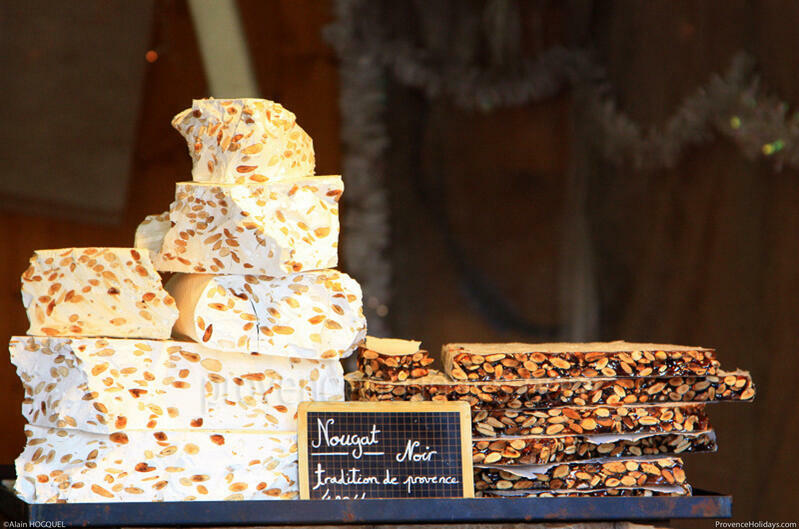Nougat
History
Nougat has existed in the East since antiquity. It was made with almonds, honey and spices but, in Greece, it was made with nuts. In the 17th century, it was imported to Provence where Marseille obtained a monopoly by using the same recipe as the Greeks. At that time, an Ardèche agronomist called Olivier de Serres decided to plant almond trees near Montélimar. He used the almonds to make nougat and was immediately very successful. The nougat of Montélimar became famous and surpassed that of Marseille.
From 1650, to aerate and whiten the paste, adding egg white was introduced, but the current recipe for white nougat appeared in 1730. This delicacy acquired international fame at the end of the 19th century, thanks to Emile Loubet. A local man, born near Montélimar and President of the Republic from 1899 to 1906, he liked to offer nougat to all the personalities visiting the Élysée Palace. It is thanks to him that this sweet is known abroad.
A determining factor that allowed nougat to become famous was the advent of paid holidays in 1936 and the geographical location of Montélimar, on the mythical Route Nationale 7. At a time when motorways did not exist, the French used this road to go down to the South. Numerous traffic jams formed during the great summer crossings, particularly in Montélimar. The people of Montélimar then took advantage of this to sell their speciality to visitors.
The nougat of Montélimar remains the best known, but there are many other places where nougat is made: Saint-Didier in the Vaucluse; Signes and Ollioules in the Var and Allauch in the Bouches-du-Rhône.
Varieties and Flavours
Nougat is a typical sweet in Mediterranean countries. It can be white (with egg whites) or black (without egg whites). It contains honey and/or sugar, dried fruit and/or nuts (which can be whole, broken or ground) and flavourings. Its paste, ranging from soft to hard, is usually placed between two sheets of unleavened bread. To obtain a white nougat, honey and egg whites are mixed and cooked in a bain-marie and slowly stirred for five hours. The paste doubles in volume and sugar is added, followed by almonds and pistachios.
To obtain a black nougat, simply take the honey and almonds and cook them over a high heat, stirring vigorously until the honey is caramelised and the almonds are cooked. This takes about 45 minutes. The main difference between white nougat and black nougat is the way it is cooked. The nougat is poured into moulds between two sheets of unleavened bread and must rest for a certain time before being eaten.
The white nougat and the black nougat, considered as two distinct sweets, are part of the thirteen Christmas desserts.
The Question on Everyone's Mind
Where does the word nougat come from?
Etymologically, the word comes from the 16th century Occitan 'nogat', derived from 'noga', meaning 'nut', from the Latin nux.
But a lovely legend gives us an alternate origin: a woman called Aunt Manon had two nieces, Lisa and Lina. She used to prepare a secret treat for them and the two girls would exclaim: "Aunt Manon, you spoil us!" (« Tante Manon, tu nous gâtes ! ») Little Lina then inherited a cookbook from her aunt that contained a recipe for the sweet called "Tu nous gâtes", which became the recipe for the famous nougat. (Universe of gourmets)
Where to Buy Them
Musée du Nougat, ![]() 22 avenue de Gournier, Montélimar
22 avenue de Gournier, Montélimar
Where you can not only buy it, but also learn all about this addictive treat.
L'Artisan Nougatier, ![]() 35 Boulevard Desmarais, Montélimar
35 Boulevard Desmarais, Montélimar
Douceurs du Palais, ![]() 101 Route de Valence, Montélimar
101 Route de Valence, Montélimar
Chabert & Guillot, since 1848 ![]() 4 rue Émile Monier, 26200 Montélimar
4 rue Émile Monier, 26200 Montélimar
Le Chaudron d'or, since 1949 ![]() 7 avenue du 45e Régiment-de-Transmissions, in Montélimar
7 avenue du 45e Régiment-de-Transmissions, in Montélimar
Which produces 50 tonnes of nougat per year.
Nougat Events
The Nougat Festival takes place every year around 20 July in Montélimar. It is an opportunity to enjoy a family day out alongside the nougat makers and local producers. Many activities are available and the evening ends with music.

